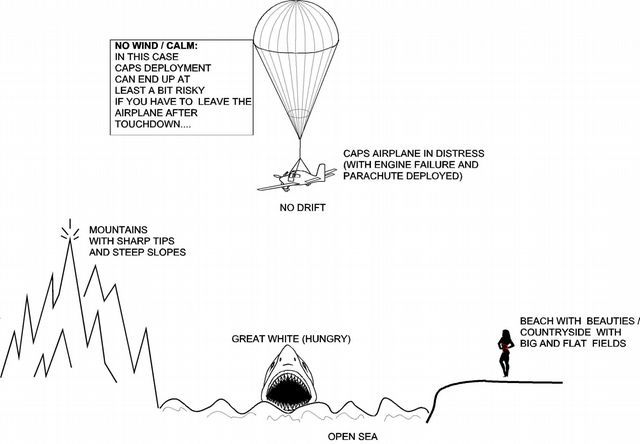Actually I think the ones that landed in forests were the safest – because many times the a/c would not even hit the ground but hang in the trees when the chute caught them. Mountains are more dangerous i guess, and there were a couple of spectacular saves: One when the wife of a dead pilot pulled and landed up high in the Rockies (unharmed) and another one that landed on a ravie, slid down until the chute caught some big rock… unharmed too, but very lucky.
One guy, he’s all over COPA, had an engine failure at night, in just a bit over 400 ft AGL, on a 3 or 4 miles final above a dense US city … landed on a Freeway, on top of a pickup truck …unharmed too, and very, very lucky. From 400 ft the plane must have touched the ground the moment the chuite was fully open.
Of course sooner or later something bad could happen, …. But I will probably not be worse than a failed dedastick landing. Let’s just hope it doesn’t happen.
PS: There was a 76 year old guy who lost control in an RNAV approach in IMC at Gloucestershire airport (i have some parts of that plane) … IO heard that he ordered a NEW one the next day (and hopefully some training too :-))
This seems to be a balanced and informative owner’s report on the Cirrus, with lots of useful information for potential type conversion.
Actually it’s not:
I have had an eMail exchange with the author, years ago, because he was still telling the tale that the SR2x has never been spin tested, and that kind of stuff, but he refused to correct his mistakes. He makes some good points about the airplane, but it’s also obvious that he has only flown the 20, not the 22.
He wrote:
“Once in a spin the SR20 and SR22 are virtually impossible to recover, according to the test pilots.
This is not only wrong, it’s completely wrong, and I am 100% sure he didn’t get that information from a “test pilot”. The SR22 was spin tested for EASA certification and in 60 spin tests it had no problem recovering. Actually it revovers like any other plane.
Flyer59 I also noted the comment, but felt the rest of the notes were positive and helpful.
The Cirrus is normal category only, so I am not sure the EASA 60 spin tests were into the fully stabilised autorotation regime; getting information on this would be of academic interest. Normal category spin testing is typically to 1 1/2 to 2 rotations with an ‘average pilot’ recovery techniques: Some with delay, or possibly out of sequence. Usually this is insufficient rotation for angular inertia to build up and be balanced by aerodynamic forces, and thereby stabilise into a fully developed autorotation spin.
It might be worth noting that the more spin resistant a design is, once it has achieved stabilised autorotation, the more difficult may be the spin recovery. The aggressive washout of the Cirrus is a positive design feature, giving good aerodynamic cues (buffet) while maintaining roll control. Criticising the Cirrus for not being tested to the utility or aerobatic spin regime seems to miss the point of spin resistant design.
Normal category spin testing is typically to 1 1/2 to 2 rotations
Yes, that they way it was tested, you can find the full report easily with Google!
I have not tried to spin the SR22, and I will not. But i am pretty sure it would spin. But also it is very well mannnered in the stall and the ailerons remain fully effective even when almost fully stalled. But i did not take it further. It’s not the type of plane i want to spin.. But contrary to P.G. i had many conversations with the pilots who test flew it for certification. They said: it will recover.
Flyer59 this may be the ELOS JAA special report?
Note as expected for a normal category aircraft, spin testing was only to the incipient stage. A fully developed spin will be test pilot territory ideally with both crew chutes and spin drag chute for the aircraft.
This tome seems quite a useful source for modern spin resistant design features.
https://easa.europa.eu/system/files/dfu/Final%20report%20EASA.2008.3.pdf
Cirrus AFMS addendum (CAPS)
Cirrus published an updated Approved Flight Manual Supplement further detailing its new philosophy regarding the use of the chute (CAPS).
The previous philosophy “pull early, pull often” is now replaced with “everybody should be pulling”.
The addendum is four pages and done graphically, based on Cirrus’ experience that computer generated images resonate best with their clientele.




(source unknown)
PS: I think CAPS is great and I would love to have it in my airplane.
Fabulous.
Haha, funny!